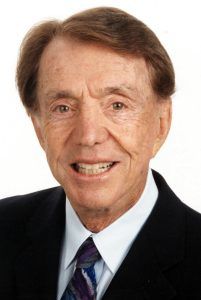
Home - Search - Browse - Alphabetic Index: 0- 1- 2- 3- 4- 5- 6- 7- 8- 9
A- B- C- D- E- F- G- H- I- J- K- L- M- N- O- P- Q- R- S- T- U- V- W- X- Y- Z
Rosen, Harold A
 Rosen Harold Credit: NASA |
Born: 1926-03-20.
Wikipedia: Harold A. Rosen (born 1926 in New Orleans, Louisiana) is an American electrical engineer, known as "the father of the geostationary satellite", and "father of the communications satellite". He formed and led the team that designed and built the first geosynchronous communications satellite, Syncom, for Hughes Aircraft Company.
Rosen graduated from Tulane University in 1947 with a Bachelor of Engineering degree in electrical engineering. He received his M.S. (1948) and Ph.D. (1951) in electrical engineering from the California Institute of Technology. Upon graduation, he began working on missile guidance and control systems for Raytheon.
In 1956 Rosen began working at Hughes Aircraft. The following year, October 1957, transformed Hughes (and the rest of the Western World) when the Union of Soviet Socialist Republics orbited the world's first artificial satellite, marking the beginning of the Space Race.
Rosen was aware of science writer Arthur C. Clarke's proposal for a geosynchronous satellite, but he and his team also recognized the problems in achieving a usable result. The daunting distance to orbit (over twenty-two thousand miles above the Earth's surface) was too high for existing rockets to attain; and once at the orbital point the platform had to be made stable. The Hughes' team solution involved creating miniature components for a much lighter unit, and achieving stability by spinning the satellite like a gyroscope.
The first satellite, Syncom I, was launched in 1961, but the launch was a failure and the satellite was lost. The second unit was successfully placed into operation in 1963; Syncom III was in orbit in 1964, in time to relay live television signals from Tokyo during the Summer Olympics.
Rosen led the Hughes team (which during that time had been absorbed by Boeing) until 1992. Upon his retirement, he joined with his brother Benjamin in another development project.
In 1993 Harold Rosen and his brother Benjamin founded Rosen Motors in Woodland Hills, California. They developed a gas turbine-powered series hybrid automotive powertrain using a 55,000 rpm flywheel energy storage subsystem to provide bursts of acceleration to augment the turbine's more steady power output. The flywheel also stored energy through regenerative braking. The flywheel was composed of a titanium hub with a carbon fiber cylinder and was gimbal mounted to minimize adverse gyroscopic effects on vehicle handling. The prototype vehicle was a Saturn, modified to accept the new engine/flywheel unit. It was successfully road tested in the Mojave Desert in January 1997 but was never mass-produced, when the automakers to whom it was demonstrated chose not to go with the flywheel technology. The company was dissolved in November 1997 after spending $24 million to develop an engine technology that promised to revolutionize the auto industry. Their sister company, Capstone Turbine Corporation (Tarzana, Los Angeles) received the company's technology and continued to develop and market it after 1997.
After the closure of Rosen Motors, Rosen became a consultant for Boeing in the design of new satellite systems.
Harold Rosen was born on March 20, 1926, in New Orleans, Louisiana. His parents, Isidore and Anne Vera Rosen, raised him during the depression in the 1930s Rosen married Rosetta. She died in 1969, after which he married Deborah Castleman. They had two sons. Rosen and his wife currently reside in Santa Monica, California.
Country: USA. Agency: Hughes. Bibliography: 535, 5950.
1926 March 20 - .
- Birth of Harold A Rosen. - . Related Persons: Rosen, Harold. American Hughes Engineer. Harold A. Rosen was one of the key scientists at the Hughes Aircraft Company who developed Syncom, the first geosynchronous communications satellite, for NASA. He received the National Medal of Technology in 1985..
Back to top of page
Home - Search - Browse - Alphabetic Index: 0- 1- 2- 3- 4- 5- 6- 7- 8- 9
A- B- C- D- E- F- G- H- I- J- K- L- M- N- O- P- Q- R- S- T- U- V- W- X- Y- Z
© 1997-2019 Mark Wade - Contact
© / Conditions for Use